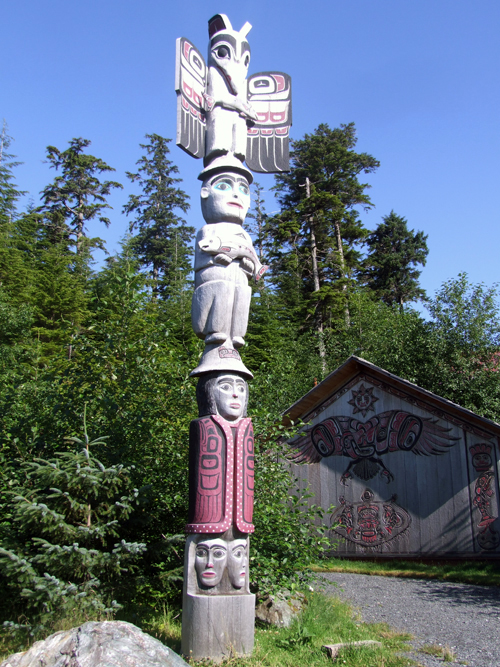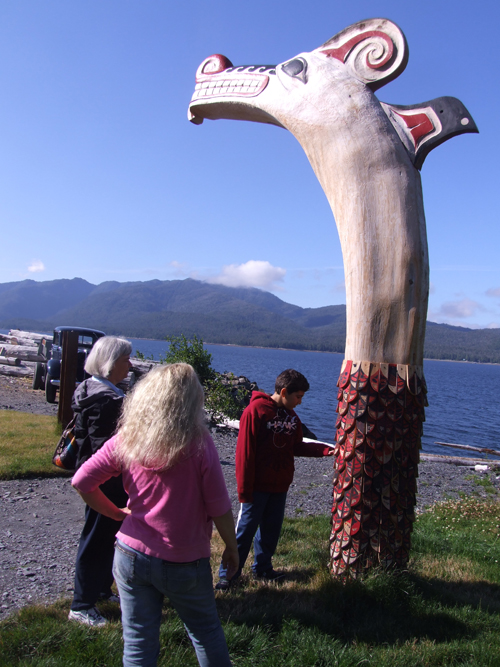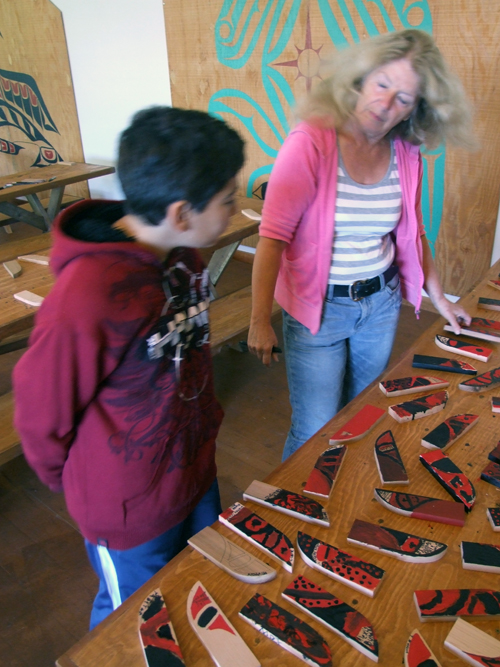
By Donald H. Harrison
KETCHIKAN, Alaska – Just as stories can be transcribed into writing in books, they also can be told with immense carvings on totem poles. The extended family that owns and operates Potlatch Park here has been producing both kinds of literature for the education and delight of the many visitors to the area.
Most members of the Tlingit or Haida tribes here would have no trouble deciphering the meaning of a totem pole bearing carvings of, from top down, an eagle, a boy holding a salmon, a grandmother in a button blanket, and the faces of two villagers.
That’s because they are the main characters of a well-known legend about a boy who left salmon for eagles to feast upon, even though food was in short supply in his village. Because they felt he was wasting precious resources, his angry neighbors decided to leave him behind when they migrated to another village. Though abandoned, the boy did not starve. Eagles saw his plight and dropped salmon after salmon back to the earth for him.
Soon he was able to fill his smoke house.
There are alternate versions of the story concerning the grandma. In one she is forced by the villagers to go with them. In the other, she stays
behind. Eventually, the villagers come back, worse off than before because there was even less salmon in the place they had gone to. When they returned, they saw that the eagles had provided enough salmon not only for the boy, but for the village as well. In both versions the grandma was justifiably proud of her little boy. And, in both, the villagers realized, to their chagrin, that all nature’s creatures must take care of each other.
Now consider another totem pole. At the top is raven. Below him is a clamshell with people coming out. Below that is a wolf with two salmon. And below the wolf is an eagle.

There is a creation legend that a giant raven found a large clamshell and being a curious bird he pecked and pecked at it until he forced it open. Inside were people. As Kanoe Zantua, one of the Potlatch Park proprietors, continues the story in his book, Alaska Legends and Talon Tales:
“After mankind came out of the clamshell, squinting from the sun rays hitting their eyes, they took a good look around. What a great world this must be. Eagles flying overhead and fish swimming in the sea….”
Though its howl is known throughout these parts, wolf typically does not get important roles in Tlingit or Haida folklore, commented Teddi Brown, mother of Kanoe and a driving force behind Potlatch Park. Typically wolves represent some of the many animals in nature. Nevertheless, in native lore, adds Woody Sivertsen, her grandson who is one of the park’s pole carvers, wolves and bears are considered “the best mothers in the world.”
During our visit, Sivertsen was working on a 32-foot western red cedar, using no electric tools, only chisels and traditional knives. The paint used by Native Alaskans on the totem poles was made from materials readily found in Ketchikan’s ecosystem, he said. “The natives here could actually
make a very early oil-based paint,” he said. “They did this by chewing salmon eggs and spitting it back into a bowl and then adding raw dies – black from charcoal, red from iron oxide and turquoise from copper oxide.”
Unlike the Native Alaskans’ totem poles, which had the bottom 5-8 feet buried in the dirt, the totem poles produced by modern carvers are mounted on concrete bases with big steel brackets, so that they will remain above ground. “Once you bury a log in this environment, it begins to leak moisture through the pole and it will rot from the inside out,” he explained.
Sivertsen has been working on the pole for about 2 ½ years, off and on between duties giving tours and working in the Potlatch Park gift shop, he said. When finished the totem pole will depict a “potlatch,” the kind of ceremonial gathering for which the park is named. Typically Native Alaskans were members of either of two large clans, the Ravens and the Eagles. In totem pole carving, Raven typically is depicted with a straight beak, whereas Eagle is depicted with a curved one. Beneath the clan level are sub-clans, and “you can have all kinds of different combinations,” Sivertsen
told us. For example, someone might be from the Orca (killer whale) subclan of the Eagle clan; or the Bear subclan, or the Wolf subclan.
The potlatch is a huge celebration when representatives of various clans and subclans come together in peace. “It’s the Fourth of July and the Holy Day season all in one,” Sivertsen said.
During the Depression of the 1930s, President Franklin D. Roosevelt had Civilian Conservation Corps workers restore an area next door to Potlatch Park today known as Totem Bight State Park. The state park has many of the same elements as Potlatch Park: clan house, smoke house, totem poles and other artifacts of Native Alaskan life It is under the jurisdiction of state park rangers.
“President Roosevelt wanted to continue Totem Bight and make a whole village, but they didn’t have the funds to finish and never got additional funds appropriated by the state,” Brown said.
She added that her family “always thought, gosh that’s a great idea, what a grand thing to finish the park.” Potlatch Park was begun as a private park in 1986. Fifteen years later, the Brown-Zantua-Silvertsen clan purchased land all the way to the waters nearby and now is adding totem poles and other structures to their park. Potlatch Park has no formal relationship with Totem Bight State Park.
Inside Potlatch Park, they built a clan house, recreating a dwelling where 40 people could sleep atop the floor boards, their possessions kept safely below them. Potlatch Park also includes a smoke house, where salmon could be smoked for preservation over alder wood for the long winter months. And, now, Potlatch Park has a Sea Monster House, where children coming on excursions on Fridays from the Disney Wonder cruise ship can participate in a project to complete a totem pole of a sea monster that is part whale and part wolf.
The children paint wooden feathers that will cover the sea monster. With two wooden sides to each feather, the project will involve the art work of 3,600 children. Although we came to Ketchikan aboard the Sea Princess, Brown graciously permitted our grandson, Shor, 10, to paint one
of the feathers in a red and black design. Shor added Mickey Mouse ears to his creation to show his appreciation to Disney for creating such an intriguing creature.


The Sea Monster walks as a wolf on land but transforms itself into a whale when in the sea, Brown said. Other legends about
this creature are still being written by Disney Imagineers.
Following Native Alaskan custom, the entrance to the Sea Monster House was built in such a way that anyone entering would be required to twist and turn to get inside. Brown explained that such strenuous motion would rob an intruder of all his energy, thereby allowing the people inside to bop him over the head in their self defense.
In the gift shop, there is a firearms museum which has in display cases various rifles and automatic weapons, including a Civil War-era Gatling gun; a rare 100-caliber rifle with a shell that holds 250 grams of double fine powder. “It would easily take down a moose, not a problem at all,” commented Zantua.
Another firearm in the museum, where walls are covered with the stuffed heads of various game, is a seven-barrel rifle. “The barrels don’t rotate, when you pull the trigger all seven fire,” he added. “In the 1800s people used it for goose hunting. As long as you didn’t shoot them too close, you were all right.”
Zantua keeps a remote control device on his person when inside the museum. It activates a large standing, stuffed bear, which suddenly moves its head and lets out a growl, sometimes prompting surprised screams from the tourists. “I have had that bear for 10 years and that never gets old,” Zantua confided.
Out on the grounds there is a small antique car museum, which adds to the fun, although its connection to the totem poles is a bit vague. Brown said some of the cars date to the 1930s—the same era that CCC workers were restoring totem poles and Native Alaskan dwellings in the area.
“Two art forms from roughly the same period,” she commented.
*
Harrison is editor of San Diego Jewish World. He may be contacted at donald.harrison@sdjewishworld.com File: US Canada West 13